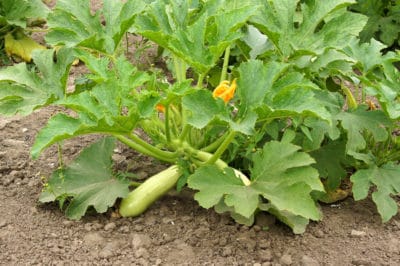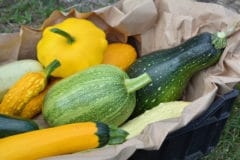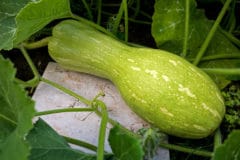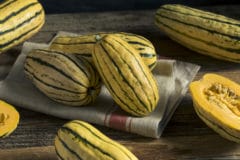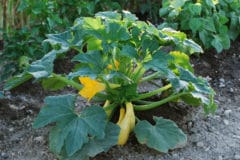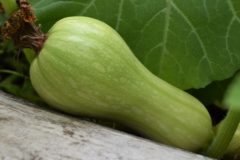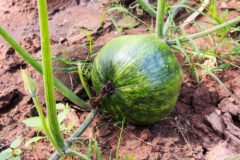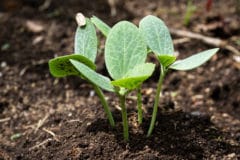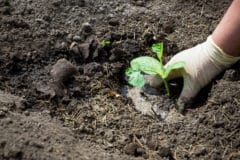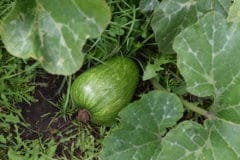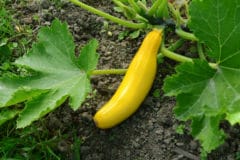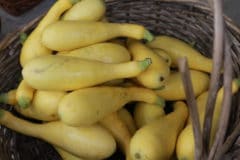What Are the General Types of Squash to Grow
Squash is generally classified as either summer or winter squash. Both are planted at the same time of the year but are harvested at different times.
What Are Some Varieties of Winter Squash
Some of the winter squash varieties to choose from are acorn squash, butternut squash, buttercup squash, banana squash, hubbard squash, and spaghetti squash. Within each of these general types are subtypes that have different characteristics.
What Are Some Varieties of Summer Squash
Summer squash types are zucchini squash, yellow crookneck squash, yellow straightneck squash, and scallop squash. These general types have numerous subtypes in their family. There are dozens of choices with different characteristics.
When to Plant Squash
Heat-loving squash plants grow best in temperatures from 65°F (18°C) to 85°F (29°C). When the soil temperature two inches (5 cm) below the surface is 60°F (16°C), it is safe to sow the seeds or plant transplants. A week or two after your last frost in the spring is usually a safe time for planting in the outdoor soil.
Which Soil Is Best for Squash Plants
A few inches of composted organic matter should be mixed in the soil to a depth of about 12 inches (30 cm). Fish fertilizer, aged manure, or a product like Dr. Earth Organic Tomato, Vegetable, and Herb Fertilizer should be added to the soil.
How Much Sun Is Necessary for Squash Plants
In addition to well-composted soil and warm temperatures, squash plants require at least six hours of full sun every day. Anything less than that will cause less than an optimal production of fruit. A wise gardener obverses the sun exposure in various parts of his yard for weeks or months before deciding the best area for his garden.
How to Sow Seeds Outdoors
The preferred method of planting squash is the direct sowing of seed outdoors. Direct sowing of seed can be in a traditional row garden or in hills that are four to eight feet in diameter. Always sow seed one inch (2.5 cm) deep and allow about three feet between plants.
How to Start Transplants Indoors
Gardeners with short summer seasons can start transplants indoors about two to four weeks before the last frost in the spring.
- Plant seeds in pots that are several inches deep.
- Sow squash seeds 3/4 inches (1.5 cm) deep in pots filled with quality seed starting mix.
- Keep moist, but do not overwater.
How to Know When Transplants Are Ready for the Garden
When seedlings have one set of true leaves, it is time to plant outdoors in the garden. The chances of the plant surviving are less once the second set of true leaves appear. When transplanting, be very gentle with plant roots.
How to Plant Squash
Gardeners use the hill or row method of planting squash. The hill method is usually preferred: it allows space for prolific growth of squash plants especially the vining varieties.
How Far Apart Should Plants Be
Hill or row planting, the distance between plants should always be approximately three feet apart. Planting too close can contribute to disease and pest problems. A good air flow is crucial in preventing these problems. Hills should be about five feet apart if more than one hill is planted.
How to Care for Squash Plants
Squash plants grow quickly into lush plants producing much fruit if they are cared for properly. If sufficient rain does not occur, water weekly at least 4 inches deep at the base of the plants. Mulch plants with wood chips or straw. Apply a side dressing of natural fertilizer when blossoms appear.
What Pests Attack Squash Plants
Some of the common pests that attack squash plants are squash bugs, aphids, squash vine borers, cucumber beetles, and stink bugs.
How Can These Pests Be Controlled
Sometimes simply locating the insect and physically removing it or the eggs are all that is necessary for pest control. Also, putting up barriers, like pantyhose around stems, can prevent moths from laying eggs that become pesky problems. If all these fail, a neem oil extract or peppermint oil and water mixture may deter pests.
What Diseases Attack Squash Plants
Fungal or viral diseases in squash plants are sometimes contracted by insects or nearby infected plants or debris. Some of the diseases that attack the squash plant are powdery mildew, downy mildew, leaf sport Septoria, Gummy Stem Blight, Choanephora fruit rot (blossom end rot), Fusarium, Anthracnose, squash mosaic virus, and bacterial wilt.
What to Do if Plants Have White Spots
Whenever squash leaves turn white the cause is powdery mildew, a fungal infection. The key in controlling this fungus is early intervention with a fungicide such as potassium bicarbonate. Other ways of controlling powdery mildew are sodium bicarbonate, neem oil, crop rotation, destroying diseased plant material, and keeping the garden free of weeds.
What to Do if Squash Rot on Ends
Choanephora fruit rot (blossom end rot) is the culprit for fruit rotting on the ends. It is a disease caused by a lack of calcium. Adding gypsum to soil may make calcium more readily available to the plant. A low nitrogen fertilizer and lime should be added also. Always remove affected fruit and use a calcium-rich foliar spray.
When Is Harvest Time for Summer Squash
Summer squash may be ready to pick as early as one week after blossoms appear. Pick the small, tender ones by gently twisting them or cutting them off with a knife. Once summer squash starts producing, be prepared to pick several from each plant every day.
How Is Summer Squash Preserved
Most plants produce enough crop to eat fresh and preservefor later use. Summer squash can be stored for up to ten days in the refrigerator. Freezing your excess summer squash is the preferred method of storing. Some gardeners dehydrate or can summer squash also.
When Is Harvest Time for Winter Squash
Winter squash is usually ready to be picked in late September through October. When the rind is hard and there is a deep color to the squash, it is usually time to harvest that particular squash. Also, vines will be more brown than green. Squash may not all be ready at the same time, so a gardener should keep a watchful eye out for ripening squash.
How Is Winter Squash Preserved
Winter squash can be stored in cool, dark places for most of the winter. Some gardeners have been able to store these hardy vegetables for up to a year. An ideal place to store them is under a bed in a box. The squash should not be touching. Another way to preserve them is to cook, puree, and freeze winter squash.
